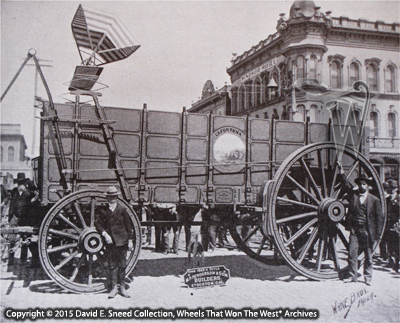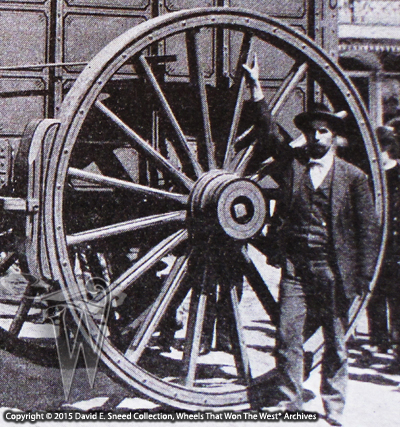Some things are hard to forget. To that point, almost twenty years ago, I purchased a book by Don Berkebile entitled, Horse-Drawn Commercial Vehicles. With over 250 images packed into 150 pages or so, the book is chock full of details related to America's first and largest transportation industry. In fact, the diversity of vehicle types shown on almost every page provides a great overview of that era, making it a must-have reference for any enthusiast's library.
Beyond those accolades, one of the things that has always struck me about this book is a photograph it holds of a giant western freight wagon. From the first time I saw it, I've never forgotten the massive scale of the piece. To me, it's a reminder of just how big the challenges and opportunities were on America's western frontier.
The wagon was handcrafted in 1899 by legendary wagon and stagecoach maker, M.P. Henderson of Stockton, California. It was ordered by C.D. Lane, a millionaire mine owner and, at the time of its completion, was billed as the largest wagon in the world (although the Death Valley wagons are arguably similar in size). Looking at how this Henderson wagon dwarfs those in the photo, it was clearly built to haul massive loads. In another way of thinking, it was also crafted to make a statement. Detailed striping, custom hardware, and the host of folks gathered in the photo all reinforce the point that this was far from a run-of-the-mill freighter. Ultimately, it was created to promote and service the Fortuna Mine - one of the most prosperous and productive gold mines in Arizona at the time. The proprietor, Charles D. Lane, also owned the famed "Utica Mine" at Angels Camp, California and the "Wild Goose" in Nome, Alaska.
 |
| This photo from the Wheels That Won The West® Archives shows the massive Fortuna freight wagon. It was built in the shops of M.P. Henderson & Son in Stockton, California. |
Mr. Berkebile includes a brief description of the vehicle in his book. He credited an 1899 issue of The Carriage Monthly for the details. Since the original write-up on the wagon actually included a bit more information than the book, we thought it would be interesting to highlight someof that in this blog. Below is a portion of that article taken from original materials in our Archives...
"M.P. Henderson & Son, Stockton, Cal., have just completed the largest wagon that ever was built. The height from the ground to the top of the seat is 13 ½ feet. The seat had to be removed before it could be shipped on the railway. The hubs are 16 x 20 inches, and the spokes 4 5/8 inches. The width of the tire is 6 inches, the depth of the rim 4 ½ inches, and the thickness of the tire is 1-inch. The front wheels are 5 feet in diameter, and the rear wheels are 8 feet. The most notable feature of the wagon is these rear wheels. The idea of having such enormous wheels is that the wagon will roll easier on the sandy roads of that country. The wagon bed is 20 feet long, and has a regular width of 3 feet 8 inches. It is 5 feet high inside. The axles are 3 ¼ inches. The complete wagon weighs 6,515 pounds, and has a carrying capacity of twelve tons. It measures 33 feet from tip of the pole to the back of the bed, and required for shipment the longest railroad flat car in use..."
Some time back, I was cataloging a few early articles in our Archives and came across yet another - even earlier - written account covering the same set of wheels. To the best of my knowledge, this discovery marks the first time this earlier report has been pointed out to modern audiences. The significance of the find lies in both the affirmation of details in the later piece identified by Don Berkebile as well as the uncovering of previously unknown information. Both reports include similar statements but, the earlier piece also shares that the vehicle was to be pulled by 18-20 draft animals.

This close-up image reinforces the impressive scale of the Fortuna freight wagon.
Additional features of the massive wagon included steel standards, double spoke rivets, 14 spokes on the front wheels and 16 on the rear, box brakes, heavy rub irons, and an adjustable brake rod. In some ways, the giant wagon looks a little like an overgrown California rack bed. Centering the bed on the lowermost sill, the insignia of M.P. Henderson & Son identifies the firm as the maker. Just above the Henderson name is a rarity for freight wagons - a handpainted scene featuring what looks to be a western landscape. Reminiscent of still life paintings embellishing the doors of period Concord stagecoaches, the extravagant painting on this freight wagon was clearly meant to reflect the wealth being uncovered in the Fortuna mine; Hence, the christened name lettered in the top center of the vehicle box - LaFortuna.
Further capturing the lucrative nature of the mining operation, an 1896 report showed that within a four month period, 6,300 tons of ore had been extracted from the Fortuna mine with the resulting gold for the brief period valued at almost a quarter million dollars. In another report, the August 16, 1900 issue (p.9) of the Los Angeles Herald newspaper indicates that the mine was still running strong at that time, producing $140,000/month.
Clearly, the wagon was part of a remarkable enterprise. Looking at the century-plus-old photo, it's easy to be impressed by the size of the vehicle. Just as engaging, though, is the thought of what may have happened to this particular Wonder of the West. With so much attention given to its debut, it's tough to think that such a magnificent icon has likely been lost to time. Fortunately, we have the written reports and the photo above to remind us of some very 'big' moments in western transportation history. Have a great week!
Please Note: As with each of our blog writings, all imagery and text is copyrighted with All Rights Reserved. The material may not be broadcast, published, rewritten, or redistributed without prior written permission from David E. Sneed, Wheels That Won The West® Archives.